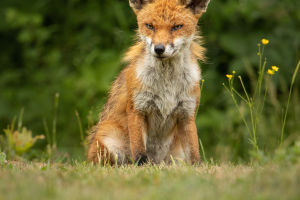Hummingbirds are fascinating and unique birds that belong to the hummingbird family of Swifts, which includes more than 300 different species of birds. They are among the smallest birds in the world, and their buzzing sound when they fly makes them easily recognizable.
Hummingbirds are only found in the Americas, although they are known to live in tropical rainforests and can be found in much of North and South America.
The bee hummingbird, the smallest hummingbird in existence, is only 5 cm long and weighs less than 2 grams. The origin of hummingbirds is still unclear, although fossils found in Europe indicate that they appeared on Earth as early as 30 million years ago.
Fossil preservation is challenging due to their small size, making it difficult to determine how they became a bird unique to the Americas.
Hummingbirds have blue or green plumage, with lighter underparts, and some male birds have a crest or slender tail feathers. Male birds are usually blue-green, while others are purple, red, or yellow. The female bird's body plumage is darker.
Hummingbirds have a variety of beak morphologies, and the different lengths and shapes of their beaks indicate the different flowers they eat. Hummingbirds have extendable, forked tongues that allow them to drink nectar.
Despite their tiny size and bright colors, hummingbirds can be quite aggressive. Some hummingbirds will protect specific trees that often contain their favorite flowers and nectar, and they will even keep larger birds at bay.
These birds live in small, compact quarters, while others forage in a larger range, usually following a fixed route to a fixed wood or shrub. Hummingbirds are fast fliers and can fly long distances, reaching speeds of up to 80 kilometers per hour.
Hummingbirds have excellent flying skills and amazing speed. Their short, mighty wings beat up to 70 times per second, and they have the fastest metabolism of any animal. Their heartbeat can reach 500 beats per minute.
Hummingbirds consume far more than their body weight in food every day, and to obtain this huge amount of food, they must forage on hundreds of flowers every day.
In addition to sucking nectar, hummingbirds also eat small insects, such as mosquitoes and spiders. The nectar in their diet provides a lot of energy, as well as vitamins and minerals that keep hummingbirds alive and reproducing.
The way hummingbirds reproduce is also unique. The male bird will display his wings and feathers to show his beauty and grace to the female bird. If the female bird is interested in the male bird, they will build a nest together and hatch the eggs. The incubation period is generally 2-3 weeks, and the hatched chicks need to stay in the nest for several weeks before they can leave the nest.
Due to the dwindling number of hummingbirds, some countries and regions have begun to protect them. Some captive-bred hummingbirds have been introduced to some areas to increase local hummingbird populations.
At the same time, to protect these unique birds, people have begun to pay attention to and study their ecological environment and living habits to preserve them better.
Hummingbirds are unique birds with fascinating ecological behaviors, flying skills, and amazing speed. With their declining numbers, it is important to take steps to protect them and their habitats. By studying and understanding their ecology and behavior, we can take appropriate measures to preserve them for future generations to enjoy.


